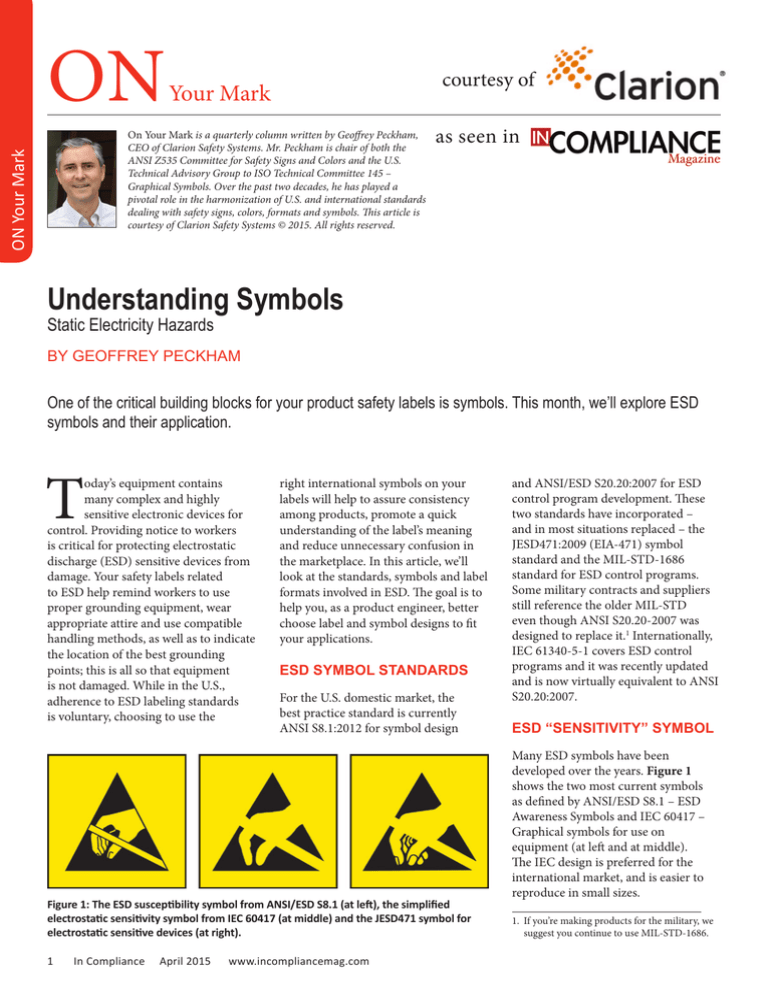
ON
courtesy of
Your Mark
ON Your Mark
On Your Mark is a quarterly column written by Geoffrey Peckham,
CEO of Clarion Safety Systems. Mr. Peckham is chair of both the
ANSI Z535 Committee for Safety Signs and Colors and the U.S.
Technical Advisory Group to ISO Technical Committee 145 –
Graphical Symbols. Over the past two decades, he has played a
pivotal role in the harmonization of U.S. and international standards
dealing with safety signs, colors, formats and symbols. This article is
courtesy of Clarion Safety Systems © 2015. All rights reserved.
as seen in
Understanding Symbols
Static Electricity Hazards
BY GEOFFREY PECKHAM
One of the critical building blocks for your product safety labels is symbols. This month, we’ll explore ESD
symbols and their application.
T
oday’s equipment contains
many complex and highly
sensitive electronic devices for
control. Providing notice to workers
is critical for protecting electrostatic
discharge (ESD) sensitive devices from
damage. Your safety labels related
to ESD help remind workers to use
proper grounding equipment, wear
appropriate attire and use compatible
handling methods, as well as to indicate
the location of the best grounding
points; this is all so that equipment
is not damaged. While in the U.S.,
adherence to ESD labeling standards
is voluntary, choosing to use the
right international symbols on your
labels will help to assure consistency
among products, promote a quick
understanding of the label’s meaning
and reduce unnecessary confusion in
the marketplace. In this article, we’ll
look at the standards, symbols and label
formats involved in ESD. The goal is to
help you, as a product engineer, better
choose label and symbol designs to fit
your applications.
ESD SYMBOL STANDARDS
For the U.S. domestic market, the
best practice standard is currently
ANSI S8.1:2012 for symbol design
Figure 1: The ESD susceptibility symbol from ANSI/ESD S8.1 (at left), the simplified
electrostatic sensitivity symbol from IEC 60417 (at middle) and the JESD471 symbol for
electrostatic sensitive devices (at right).
1
In Compliance
April 2015
www.incompliancemag.com
and ANSI/ESD S20.20:2007 for ESD
control program development. These
two standards have incorporated –
and in most situations replaced – the
JESD471:2009 (EIA-471) symbol
standard and the MIL-STD-1686
standard for ESD control programs.
Some military contracts and suppliers
still reference the older MIL-STD
even though ANSI S20.20-2007 was
designed to replace it.1 Internationally,
IEC 61340-5-1 covers ESD control
programs and it was recently updated
and is now virtually equivalent to ANSI
S20.20:2007.
ESD “SENSITIVITY” SYMBOL
Many ESD symbols have been
developed over the years. Figure 1
shows the two most current symbols
as defined by ANSI/ESD S8.1 – ESD
Awareness Symbols and IEC 60417 –
Graphical symbols for use on
equipment (at left and at middle).
The IEC design is preferred for the
international market, and is easier to
reproduce in small sizes.
1. If you’re making products for the military, we
suggest you continue to use MIL-STD-1686.
ON Your Mark
ON
Your Mark
The ESD sensitivity/susceptibility
symbol is to be used on ESD sensitive
components, assemblies, packaging
containing ESD devices or the access
panel to ESD sensitive devices. Black
on a yellow background is the preferred
color scheme. The ANSI standard
gives you the option to include a
sensitivity-based alphanumeric
code to tell people the proper level
of precautions necessary to avoid
damage to the equipment. For military
standards, there are specific word
messages to be paired with the JESD471
symbol (see Figure 1, at right). The
standards suggest that the symbol
be black on a yellow background,
but monochromatic reproduction
in any color that contrasts with the
background may be used.
at the entrance to an EPA and at
the workstation. ANSI/ESD S8.1
states that the word message, “May
include manufacturer’s name, date
of manufacture, or lot code where
applicable.” The preferred color is
yellow on a black background.
ESD “COMMON GROUND
POINT” SYMBOL
ANSI S8.1 also has a symbol for
“common ground point.” IEC 60417
has a similar wordless symbol meaning
“earth; ground.” See Figure 3.
This ESD-related symbol is used to
indicate the location of an acceptable
common ground point as described in
ANSI/ESD S6.1. The colors are optional
per the standard, but it suggests either
using black or using white on green.
The common ground point symbol is
used in an EPA for identifying where
to attach ground wires when servicing
equipment in the field or in your
facility. If possible, the inner circle of
this label should be the location of the
ground post or socket.
ESD “PROTECTIVE” SYMBOL
The ANSI S8.1 standard and IEC
61340-5-3 both prescribe symbols to
be used to either 1) identify protective
packaging materials or 2) identify an
electrostatic protective area (EPA)
where ESD precautions are in place (see
Figure 2). The ESD protective symbol
differs from the ESD sensitivity symbol
by removing the slash and adding a
‘bold arc’ around the triangle to suggest
the idea of protection. In Europe, a
letter is added to identify the type of
protection provided by a package. As
described in IEC 61340-5-3, the four
letter codes for IEC 60417 6202 are:
Figure 2: The ESD protective symbol from ANSI S8.1 (at left) and the IEC packaging version
of the symbol from IEC 60417 (at right). The ‘*’ in the IEC symbol is for the letter code to
be added.
S for electrostatic discharge shielding
F for electrostatic field shielding
C for electrostatic conductive
D for electrostatic dissipative
In addition to identifying protective
packaging, the ESD protective symbol
is also used on signage, tapes, physical
barriers and markings for ESD
protective areas (EPA), protective
garments, shoes and equipment.
Guidelines suggest having a sign
2
In Compliance
April 2015
Figure 3: The common ground point symbol from ANSI S8.1 (at left) and the general earth
(ground) terminal identification symbol from IEC 60417 (at right).
www.incompliancemag.com
ON Your Mark
ON
Your Mark
HARMONIZATION WITH ANSI Z535
When it comes to your ESD label’s content, some of
the older standards refer to “CAUTION” as the signal
word to use when warning about part and assembly
damage from ESD. Other standards specify the use
of “ATTENTION”. Per ANSI Z535 (the standard
in the U.S. which sets the overall benchmark for
product safety labeling), “NOTICE” is the more
appropriate choice for an ESD label’s signal word.
“NOTICE” is used to indicate information to avoid
equipment damage (in contrast to using the signal
words DANGER, WARNING or CAUTION which
are used to indicate potential personal injury hazards).
The ANSI Z535.4 Standard for Product Safety Signs
and Labels can be used for ESD labels – harmonizing
with IEC standards by incorporating one of the three
internationally recognized ESD symbols discussed
above into the symbol panel of an ANSI Z535.4
label (see Figure 4). Taking this extra step towards
harmonization will help to ensure consistency with the
latest best practice standards in the U.S., and will help
to maintain consistency within your product’s overall
system of safety labels.
Stay tuned for the next article in this year’s On Your
Mark series which will explore the history and progress
in standardized symbols related to laser labeling.
Figure 4: Examples of ANSI Z535-style ESD labels. (Designs ©2015 Clarion Safety Systems. All rights reserved.)
3
In Compliance
April 2015
www.incompliancemag.com



